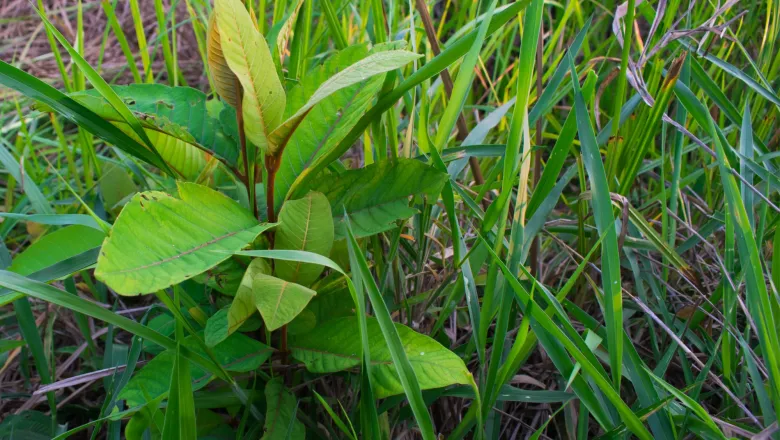Common Pasture Weeds Identification and Management

Farm Management Resources
Create a plan for the management of common pasture weeds. If you are looking to identify pasture weeds by photo, read on. Pasture weeds identification will determine if they are annual, biennial, or perennial weeds. Understanding the three lifecycle types helps us spray at the weed’s most susceptible periods. When creating a management plan, consider identification, timing, and type of herbicide. The most common cause of ineffective herbicide application is wrong timing. The application timing is critical and key to weed control in pastures and hay.
Annuals
An annual is a plant that completes its entire lifecycle in one year or one growing season. They exclusively come from seed. They grow vegetatively, become reproductive and flower, and produce new seeds within one year.
Examples: Ragweed, Cocklbur, Spiny pigweed, Jimsonweed, Yellow rocket, Purple deadnettle, Annual buttercup, Chickweed
Application timing: The best time to apply herbicide to be most effective is in the seedling stage. Usually under 5-6” tall. Always read the label on the product.
Biennials
A biennial is a plant that takes two years or two growing seasons to complete its lifecycle. These weeds are dependent on seed production to survive. They germinate and become a seedling in year one. They grow vegetatively and in size during year two and may overwinter as a rosette. In the second growing season, they bolt in upright growth and produce a reproductive stock with a flower and seeds. The weed then seeds and dies.
Examples: Wild carrot, Burdock, Common mullein, Thistles
Application timing: The best time to apply herbicide to be most effective is the seedling and rosette stage. Always read the label on the product.
Herbicides for Annual & Biennials
- 2, 4-D, Dicamba
- Pyridines (GrazonNext HL, DuraCor) – Has residual activity
- Cimarron (great on Mullein)
Course of action: Scout the pasture every season, look for biennial rosettes and seedling annuals, and apply the herbicide when they are small.
Precautions with Residual Herbicides
Some active ingredients of herbicides have a relatively long persistence and are referred to as “residual” herbicides. A residual herbicide allows for extended control of weeds. It can also risk chemicals moving off-site through animal manure or hay. Read and follow all labels which outline forage and manure management when using residual herbicides.
Perennials
A plant that persists from year to year and has a long lifespan. They are not dependent on seed production to help them spread. They sometimes spread vegetatively, or by roots, rhizomes (a spreading underground stem), or dormant buds. They are often the hardest to control because these “perennial storage organs” are energy storage for the plants and may contain buds that can be dormant, and when ideal conditions arise, they pop up a new plant from the bud.
Examples: Curly dock, Bladder campion, Dogbane, Milkweed, Chicory
How to Manage Perennials Weeds
We must view perennials differently. Efforts to manage consist of a long-term campaign to weaken underground storage organs.
Herbicides for Perennials
- Pyradines (GrazonNext HL, DuraCor, Surmount)(cannot be used in hay settings)
- PastureGard HL, Remedy, Crossbow (better on woody species)
- Remember-immediate top kill is not a good indicator of long-term control
The general pathway of pasture herbicides is to follow the path of sugar flow in the plant. When a perennial has above-ground new growth, the flow of sugar is upward. Try not to spray perennials first coming out in the spring. During early summer, the weed has much more growth and an adequate surface area and producing more energy than they need, the flow of sugar will be downward, resulting in a more effective time to apply herbicide. During late summer the plant is expending energy to produce flowers and fruit, so the energy flow is again upward resulting in ineffective herbicide application. After a perennial produces fruit in the fall, it becomes geared to energy storage, and sugar flow is again downward, resulting in good timing for herbicide application. Fall tends to be the best time to manage perennials in pastures.
Course of Action: Don’t wait until they are a big problem. Takes steps to spot spray, mow, etc., to get on top of the problem. Plan on spraying 2-3 years in a row to correct the problem. Don’t be afraid to mow and spray in the same year. Try to give forages a competitive chance. Don’t overgraze and maintain good levels of pH and fertility.
2023 Herbicide Resource
These resources were developed for weeds in Virginia, however, similar weeds are found in our neighboring states. Refer to your local Cooperative Extension service for additional information.
For herbicide recipes for the problem weeds on your farm, view the updated 2023 Hay & Pasture Herbicide Guide. It provides weed-specific herbicide recipes for broadcast and spot-spray applications, as well as color photos of our most common hay and pasture weeds in Virginia.
Educational Video
Watch a presentation on the topic in the Knowledge Center AgHub. You'll find this information and a recording of the author, Matt Booher, as he covers the topic and provides multiple images of the weeds he discusses in this blog article. Request FREE access to the AgHub.
Author:

Matt Booher, Extension Agent, Agriculture and Natural Resources Crop and Soil Sciences
Virginia Cooperative Extension, Virginia Tech
Located out of the Rockingham Extension Office and serves the counties of Rockingham, Augusta, Rockbridge, Bath, and Highland.
Matt produces and publishes The Fenceline newsletter. To subscribe, contact Matt Booher at mrb260@vt.edu. Matt can also be reached at 540-564-3080.